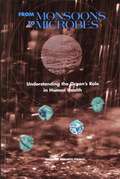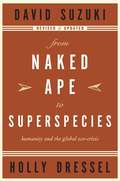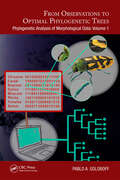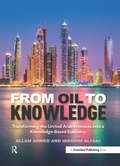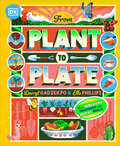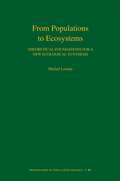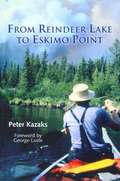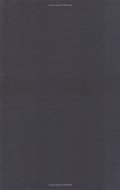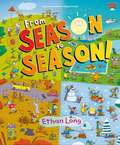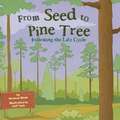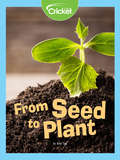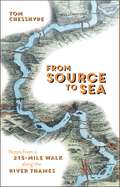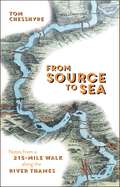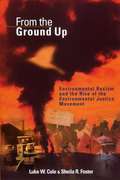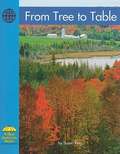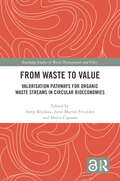- Table View
- List View
From Monsoons to Microbes: Understanding the Ocean's Role in Human Health
by National Research CouncilWhat can sharks teach us about our immune system? What can horseshoe crabs show us about eyesight?The more we learn about the ocean, the more we realize how critical these vast bodies of water are to our health and well-being. Sometimes the ocean helps us, as when a marine organism yields a new medical treatment. At other times, the ocean poses the threat of coastal storm surges or toxic algal blooms.From Monsoons to Microbes offers a deeper look into the oceans that surround us, often nuturing yet sometimes harming humankind. This book explores the links among physical oceanography, public health, epidemiology, marine biology, and medicine in understanding what the ocean has to offer. It will help readers grasp such important points as: How the ocean's sweeping physical processes create long-term phenomena such as El Nino and short-term disastrous events such as tsunamis--including what communities can do to prepare.What medicines and nutritional products have come from the ocean and what the prospects are for more such discoveries.How estuaries work--where salt and fresh water meet--and what can go wrong, as in the 7,000 square mile "dead zone" at the out-flow of the Mississippi River.How the growing demand for seafood and the expansion of ocean-going transport has increased our exposure to infectious agents--and how these agents can be tracked down and fought.Why "red tides" of toxic algae suddenly appear in previously unaffected coastal areas, and what happens when algal toxins find their way into our food supply or the air we breathe. The book recommends ways we can implement exciting new technologies to monitor the physics, chemistry, and biology of the ocean to recognize change as it happens. From the impact of worldwide atmospheric warming to the significance of exotic bacteria from submarine hydrothermal vents, the ocean has many depths left to explore.
From Naked Ape to Superspecies
by David Suzuki Holly DresselFor millennia, we lived in harmony with the Earth, taking only what we required to survive. But in just the past few centuries, we have used our powers to satisfy our obsession with consumption and new technology, without regard for the consequences. And in doing so, we have exploited our surroundings on an unprecedented scale. In this revised and updated edition of From Naked Ape to Superspecies, David Suzuki and Holly Dressel lucidly describe how we have evolved beyond our needs, trampling other species, believing that we can make the Earth work the way we want it to. And they introduce us to the people who are fighting back, those who are resisting the inexorable advance of the "global economy" juggernaut, the people whose voices are difficult to hear over the din of corporate public relations machines. We learn about how human arrogance-demonstrated by our disregard for the small and microscopic species that constitute the Earth's engine and our reckless use of technological inventions like powerful herbicides or genetically engineered crops-is threatening the health of our children and the safety of our food supply.
From Observations to Optimal Phylogenetic Trees: Phylogenetic Analysis of Morphological Data: Volume 1 (Species and Systematics)
by Pablo A. GoloboffTaxonomists specializing in different groups once based phylogenetic analysis only on morphological data; molecular data was used more rarely. Although molecular systematics is routine today, the use of morphological data continues to be important, especially for phylogenetic placement of many taxa known only from fossils and rare or difficult to collect species. In addition, morphological analyses help identify potential biases in molecular analyses. And finally, scenarios with respect to morphology continue to motivate biologists: the beauty of a cheetah or a baobab does not lie in their DNA sequence, but instead on what they are and do! This book is an up-to-date revision of methods and principles of phylogenetic analysis of morphological data. It is also a general guide for using the computer program TNT in the analysis of such data. The book covers the main aspects of phylogenetic analysis and general methods to compare classifications derived from molecules and morphology. The basic aspects of molecular analysis are covered only as needed to highlight the differences with methods and assumptions for analysis of morphological datasets.
From Oil to Knowledge: Transforming the United Arab Emirates into a Knowledge-Based Economy
by Allam Ahmed Ibrahim AlfakiOver-reliance on oil challenges the long-term sustainability of an economy. The UAE’s government has placed considerable focus on a comprehensive strategic planning exercise to transform the country’s economic structure from relying heavily on hydrocarbon resources to becoming a knowledge-based economy. Non-oil is to account for 80% of the country’s economy by 2021. From Oil to Knowledge examines the role of this major powerhouse of the Arab World to transform itself into a leader in the adoption of science, technology and innovation to drive economic success on the international stage.In this first book to present and critically evaluate the extent of the UAE’s success in diversifying its economy and implementing the principles and approaches of a Knowledge Economy, the authors identify the achievements of the government to date and the areas of further development. From Oil to Knowledge will be utilized as a guide by policymakers and senior managers to enhance their ability to think strategically towards implementing the pillars of a Knowledge Economy within their own organisations and nation states.
From Plant to Plate: Turn Home-Grown Ingredients Into Healthy Meals!
by Ella Phillips Darryl GadzekpoGrow mighty ingredients, then take them from mud kitchen to real kitchen and transform them into delicious, plant-powered feasts.Grab your shovel and plant for a recipe! Discover 15 incredible plants, including zucchini, raspberries, corn, and basil, then find out what it takes to make them grow. From showing you how seeds should be properly planted to helping you find the best soil for your plants, Darryl Gadzekpo and Ella Phillips offer all the tips and tricks green-fingered kids need to know to transform seeds into mighty fruit, vegetables, and herbs your tummies would be proud of.But the fun doesn't end here! Once you've removed those muddy boots, head to the kitchen and learn how to prepare and cook your home-grown ingredients. With more than 25 tasty recipe ideas from basil pesto pasta to butternut squash muffins, you'll master a variety of unique plant-powered food that you'll love to eat as much as you love to cook.A visual feast for 7–9-year-olds, From Plant to Plate is the perfect book to inspire kids to get growing, get cooking, and get plant-powered eating.
From Populations to Ecosystems: Theoretical Foundations for a New Ecological Synthesis (MPB-46) (Monographs in Population Biology #46)
by Michel LoreauThe major subdisciplines of ecology--population ecology, community ecology, ecosystem ecology, and evolutionary ecology--have diverged increasingly in recent decades. What is critically needed today is an integrated, real-world approach to ecology that reflects the interdependency of biodiversity and ecosystem functioning. From Populations to Ecosystems proposes an innovative theoretical synthesis that will enable us to advance our fundamental understanding of ecological systems and help us to respond to today's emerging global ecological crisis. Michel Loreau begins by explaining how the principles of population dynamics and ecosystem functioning can be merged. He then addresses key issues in the study of biodiversity and ecosystems, such as functional complementarity, food webs, stability and complexity, material cycling, and metacommunities. Loreau describes the most recent theoretical advances that link the properties of individual populations to the aggregate properties of communities, and the properties of functional groups or trophic levels to the functioning of whole ecosystems, placing special emphasis on the relationship between biodiversity and ecosystem functioning. Finally, he turns his attention to the controversial issue of the evolution of entire ecosystems and their properties, laying the theoretical foundations for a genuine evolutionary ecosystem ecology. From Populations to Ecosystems points the way to a much-needed synthesis in ecology, one that offers a fuller understanding of ecosystem processes in the natural world.
From Reindeer Lake to Eskimo Point
by Peter Kazaks George LusteCanoe across large lakes, up and down rivers and rapids; labour over portages and through a miasma of blackflies; bask in the golden evenings of the Subarctic. In this account of an 800-mile canoe trip – which begins at Reindeer Lake on the Manitoba/Saskatchewan border, continues into Nunavut past the treeline, and ends on Hudson Bay – Peter Kazaks conveys the experience of being in the north by describing the daily details that bring the trip to life. He captures the flavour of an extended wilderness canoe trip and reflects on living in unfettered wilderness. The reader will also grasp something of the serene beauty of the barren lands and begin to understand why its intoxicating nature keeps drawing some back. The first half of the trip, essentially from Reindeer Lake to Nueltin Lake, retraces P.G. Downes’ voyage described in his classic Sleeping Island. Next the four men of this expedition, led by George Luste, entered the barren lands and followed the Thlewiaza River, the Kognak River, South Henik Lake and the Maguse River north and east to the shore of Hudson Bay. These lands, seldom visited, are close to a true wilderness – one of the few remaining ones.
From Resource Scarcity to Ecological Security: Exploring New Limits to Growth
by Dennis Pirages Ken CousinsA new recognition of profound interconnections between social and natural systems is challenging conventional constructs and the policy predispositions informed by them. Our current intellectual challenge is to develop the analytical and theoretical underpinnings of an understanding of the relationship between the social and the natural systems. Our policy challenge is to identify and implement effective decision-making approaches to managing the global environment.
From Rocky Waters to a Smooth Finish: Neal Petersen's Story (Fountas & Pinnell LLI Purple #Level S)
by Helen ScullyBorn dark-skinned in South Africa and with a missing hip joint, Neal Petersen faced many challenges to achieve his dream of sailing around the world.
From Season to Season: Happy County Book 4 (Happy County #4)
by Ethan LongEthan Long’s From Season to Season is the fourth book in the Happy County preschool picture book series featuring earth science and educational activities about winter, spring, summer, and fall. For readers who love Richard Scarry’s Busytown books.Adventure awaits in another exciting trip through Happy County—where each new season packs plenty of surprises! Farmer Dell rides his tractor through the crops all summer long; Jimmy and Sammy search for Grammy Tammy in the autumn corn maze; Dolly and Molly build an igloo with the fresh winter snow; and Miss Humdiddy’s flower garden buzzes with pollination when spring arrives. This primer compendium is filled with lovable characters and educational content connected to weather, geography, earth science, word identifications, as well as the concepts of shapes, patterns, telling time, and grammar—all delivered through plenty of clever scenarios to keep little ones engaged and curious. Christy Ottaviano Books
From Seed to Pine Tree: Following the Life Cycle (Into Reading, Read Aloud Module 8 #1)
by Suzanne Slade Jeff YeshNIMAC-sourced textbook
From Seed to Plant
by Amy TaoInside every seed waits a tiny plant, ready to grow. Watch the process of a pumpkin plant from tiny seed to full-size fruit! You'll also see other plant seeds, which come in many different sizes, shapes, and colors. Some can be as big as your head, but poppy seeds are so little you can hold hundreds in one hand!
From Seed to Plant
by Gail GibbonsExplores the intricate relationship between seeds and the plants which they produce. [This text is listed as an example that meets Common Core Standards in English language arts in grades 2-3 at http://www.corestandards.org.]
From Seed to Plant (Into Reading, Trade Book #8)
by Gail GibbonsNIMAC-sourced textbook <P><P>With simple language and bright illustrations, non-fiction master Gail Gibbons introduces young readers to the processes of pollination, seed formation, and germination. Important vocabulary is reinforced with accessible explanation and colorful, clear diagrams showing the parts of plants, the wide variety of seeds, and how they grow. <P><P>The book includes instructions for a seed-growing project, and a page of interesting facts about plants, seeds, and flowers. A nonfiction classic, and a perfect companion for early science lessons and curious young gardeners.
From Seed to Plant (Journeys 2014)
by Gail GibbonsFlowers, trees, fruits—plants are all around us, but where do they come from? With simple language and bright illustrations, non-fiction master Gail Gibbons introduces young readers to the processes of pollination, seed formation, and germination. Important vocabulary is reinforced with accessible explanation and colorful, clear diagrams showing the parts of plants, the wide variety of seeds, and how they grow. The book includes instructions for a seed-growing project, and a page of interesting facts about plants, seeds, and flowers. A nonfiction classic, and a perfect companion for early science lessons and curious young gardeners. According to The Washington Post, Gail Gibbons "has taught more preschoolers and early readers about the world than any other children's writer-illustrator." Ms. Gibbons is the author of more than 100 books for young readers, including the bestselling titles From Seed to Plant and Monarch Butterfly. Her many honors include the Washington Post/Childrens Book Guild Nonfiction Award and the NSTA Outstanding Science Trade Book Award. From Seed to Plant was included in the Common Core State Standards Appendix B.
From Seed to Pumpkin
by Wendy PfefferIn the fall, pumpkins are everywhere: in the garden, in the supermarkets, and on doorsteps. But do you know how they grow from a tiny yellow seed to a big orange pumpkin? Read and find out! <p><p>[This text is listed as an example that meets Common Core Standards in English language arts for K-1 at http://www.corestandards.org.]</p>
From Seed to Sunflower
by Dr Gerald LeggThis basic introduction uses the example of a sunflower to describe the year-long process by which a seed becomes a plant that can grow seeds of its own. Though the illustrations often employ interesting perspectives, their tones are unappealing garish. Brief Sunflower Facts and a growth time line are appended.
From Source to Sea: Notes from a 215-Mile Walk Along the River Thames
by Tom ChesshyreAuthors, artists and amblers have always felt the pull of the Thames, and now Tom Chesshyre is following in their footsteps. He’s walking more than 200 miles from the Cotswolds to the North Sea. Seeing some familiar sights through new eyes, Chesshyre explores the living present and remarkable past of England’s longest and most iconic river.
From Source to Sea: Notes from a 215-Mile Walk Along the River Thames
by Tom ChesshyreAuthors, artists and amblers have always felt the pull of the Thames, and now Tom Chesshyre is following in their footsteps. He’s walking more than 200 miles from the Cotswolds to the North Sea. Seeing some familiar sights through new eyes, Chesshyre explores the living present and remarkable past of England’s longest and most iconic river.
From Source to Sea: Notes from a 215-Mile Walk Along the River Thames
by Tom ChesshyreAuthors, artists and amblers have always felt the pull of the Thames, and now Tom Chesshyre is following in their footsteps. He’s walking more than 200 miles from the Cotswolds to the North Sea. Seeing some familiar sights through new eyes, Chesshyre explores the living present and remarkable past of England’s longest and most iconic river.
From Source to Sea: Notes from a 215-Mile Walk Along the River Thames
by Tom ChesshyreAuthors, artists and amblers have always felt the pull of the Thames, and now Tom Chesshyre is following in their footsteps. He’s walking more than 200 miles from the Cotswolds to the North Sea. Seeing some familiar sights through new eyes, Chesshyre explores the living present and remarkable past of England’s longest and most iconic river.
From The Ground Up: Environmental Racism and the Rise of the Environmental Justice Movement
by Luke W. Cole Sheila R. FosterWhen Bill Clinton signed an Executive Order on Environmental Justice in 1994, the phenomenon of environmental racism--the disproportionate impact of environmental hazards, particularly toxic waste dumps and polluting factories, on people of color and low-income communities--gained unprecedented recognition. Behind the President's signature, however, lies a remarkable tale of grassroots activism and political mobilization. Today, thousands of activists in hundreds of locales are fighting for their children, their communities, their quality of life, and their health. From the Ground Up critically examines one of the fastest growing social movements in the United States, the movement for environmental justice. Tracing the movement's roots, Luke Cole and Sheila Foster combine long-time activism with powerful storytelling to provide gripping case studies of communities across the U. S--towns like Kettleman City, California; Chester, Pennsylvania; and Dilkon, Arizona--and their struggles against corporate polluters. The authors effectively use social, economic and legal analysis to illustrate the historical and contemporary causes for environmental racism. Environmental justice struggles, they demonstrate, transform individuals, communities, institutions and even the nation as a whole.
From Tree to Table
by Susan RingThis book reviews the process of gathering, making, and selling maple syrup.
From Waste to Value: Valorisation Pathways for Organic Waste Streams in Circular Bioeconomies (Routledge Studies in Waste Management and Policy)
by Antje Klitkou Arne Martin Fevolden Marco CapassoFrom Waste to Value investigates how streams of organic waste and residues can be transformed into valuable products, to foster a transition towards a sustainable and circular bioeconomy. The studies are carried out within a cross-disciplinary framework, drawing on a diverse set of theoretical approaches and defining different valorisation pathways. Organic waste streams from households and industry are becoming a valuable resource in today’s economies. Substances that have long represented a cost to companies and a burden for society are now becoming an asset. Waste products, such as leftover food, forest residues and animal carcasses, can be turned into valuable products such as biomaterials, biochemicals and biopharmaceuticals. Exploiting these waste resources is challenging, however. It requires that companies develop new technologies and that public authorities introduce new regulation and governance models. This book helps policy-makers govern and regulate bio-based industries, and helps industry actors to identify and exploit new opportunities in the circular bioeconomy. Moreover, it provides important insights for all students and scholars concerned with renewable energy, sustainable development and climate change.
